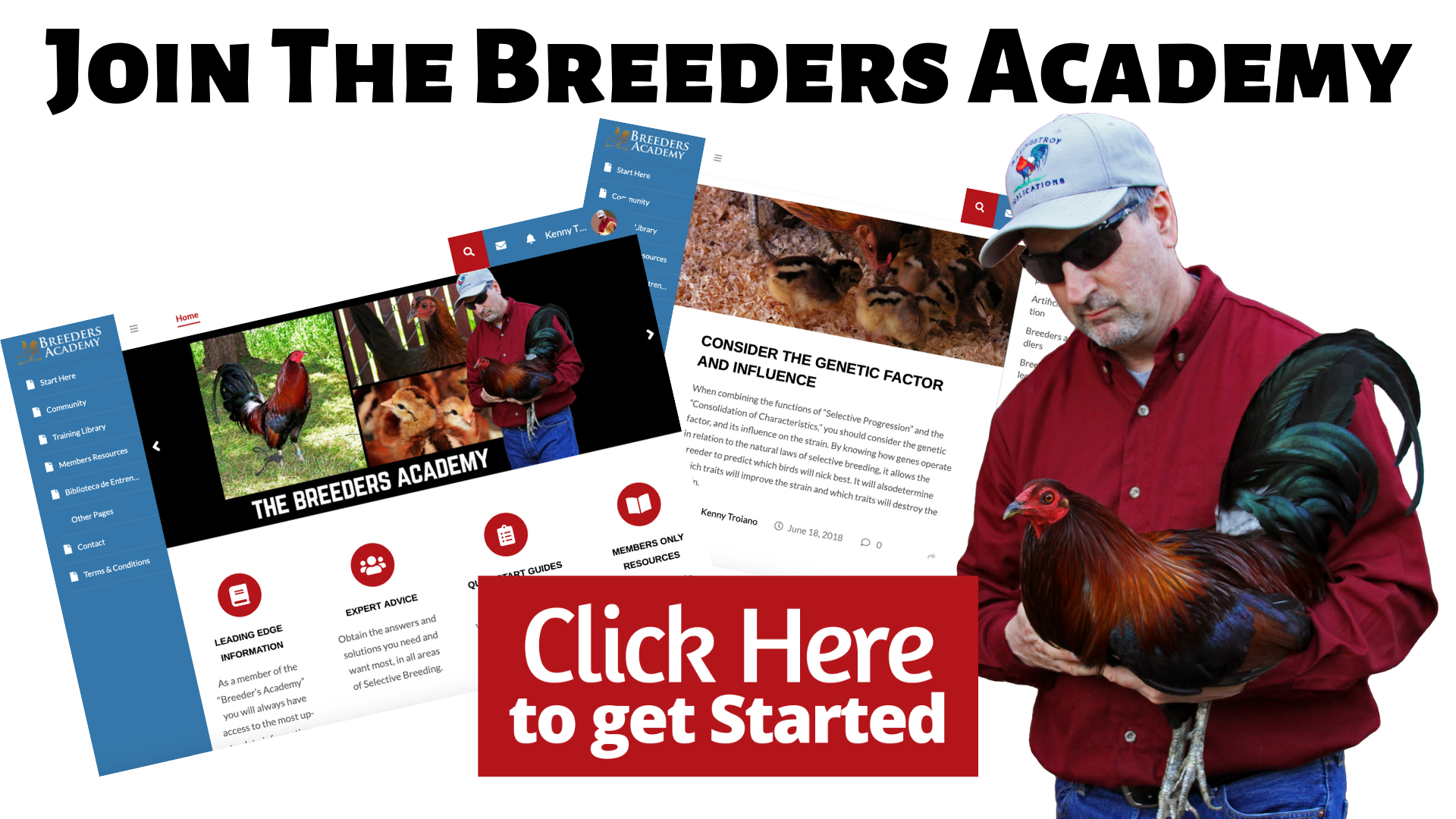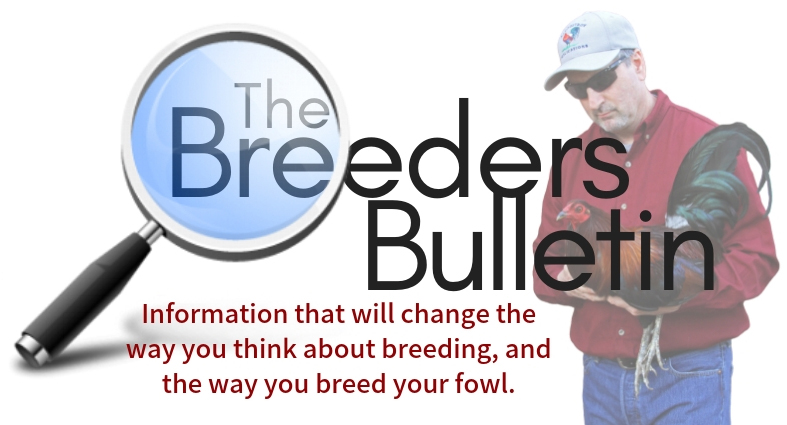And the Rise of the American Game
By Kenny Troiano
Copyright © 2019 by Kenny Troiano/Maximus Troy Publications
By what process has the small Junglefowl been converted into the breeds that we see today? What brought about the change that enables fowl, such as the American Gamecock of today to have the form and function, and the tenacious spirit of a modern-day gladiator? By what miracle has the American Game, become one of the most beautiful of all fowls, having various colors of feather, including top-knots, muffs, and large flowing tails? Well, natural selection had something to do with it, at least in the beginning, but the answer is simple, selective-breeding.
Thanks to the powers of selective-breeding there has been a tremendous opportunity for breeders to create new and improved breeds and varieties.
If you doubt the powers of selective-breeding just take a look at the evolution of the modern-day horse. The horse descended from an animal not much larger than a dog. Talking about dogs, the modern-day dog descended from the Wolf, and look at all the breeds of dogs that we today.
The chicken was no different. The modern-day chicken evolved from a two or three-pound Wild Junglefowl, a bird no bigger than most bantam breeds. Not only do we have over 200 breeds of chickens, not counting all the varieties within the breeds, but we have breeds of various functions as well.
Special Note of Interest: In the last five thousand years, the Wild Junglefowl, the ancestor of all fowl, and their characteristics and traits, has been largely lost due to the evolution of a newer and better race of fowl. Even in the wild they have changed, and not for the better either. Man has not only affected their domestic cousins, but the birds in the wild as well.
Selective breeding, not a new method: We must have no misconceptions about the breeding of fowl, for it is not a practice that is new, it has been around for a long time. The fowl we have today, such as the American Game, is the product of the past hundred or even hundred fifty years. In fact, it has taken hundreds or even thousands of years to bring them to the state of perfection that we now have them today.
Harrison Weir in “The Poultry Book” says on this point: “Nearly all our modern methods are only the old ones re-substituted.”In the olden days they bred and raised fowl with a greater confidence and in better health than many of the so-called breeders of today.
Darwin says that, “not only careful breeding, but actual selection was practiced during ancient periods, and by barely civilized races of men.” Records have shown us that in early times there were different breeds of fowl. Six or seven are mentioned as being bred and raised by the Romans at the beginning of the Christian era. This is undeniable proof that the work of selective-breeding was practiced, but it was not only practiced by the rich and the educated, it was practiced by anyone who was sophisticated enough to know how important selection actually was.
In the fifteenth century, several breeds were known to exist in Europe and in China. A lot of you probably don’t know it, but the people of the Philippine Islands, about a hundred years ago had no less than nine varieties of fowl.
Darwin said at one time: “those who in ancient times and in semi-civilized countries took pains to keep breeds distinct and who therefore valued them, would occasionally destroy inferior birds and would have preserved their best birds.” So even in ancient times the value of a strain and keeping them pure was indeed important.
The modern-day breeder: The work of the modern-day breeder has not been so much to maintain the original purity of blood, as it has been to make new breeds and varieties by infusing older, more established strains into theirs, hence, the development of the American Gamefowl.
Many present day poultry and livestock breeders breed for uniformity. They use their skills to produce overall uniformity in their stock, and because of this a standard of excellence has been developed. The nearer their stock approaches that standard the greater their value is for breeding purposes.
The importance of variation: The poultry shows demand a certain standard, and this calls for uniformity. However, there is an apparent downside to all this. Although, uniformity is important, it may not allow or permit progress or improvement of the breed. It is clear that if five thousand years ago a standard of excellence had been set up to match that of the Wild Junglefowl, there would have been no such improvement in the breeds as we have today. Improvement did not come from breeding to a set standard of uniformity. Improvement came about rather by variation. So remember, there can be no improvement without variation. In other words, if like always followed like, improvement would be impossible. I do believe a standard is valuable and important, but we must never look for ways to improve our strains.
“Like begets like” is not exactly true, it’s not even very accurate, a fact for which some of us humans may have regrets. But on the whole, the human race has improved in many ways since the days of our barbarous ancestors, largely because of this great law of heredity and the tendency to vary.
When the exceptional individual appears from average birds, this is called variation. A large bird from small parents may breed a strain or variety of large fowls. A small bird from large parents may breed a variety of small fowls. All plants and animals vary, and it is in taking advantage of this factor that our fowl in five thousand years have been bred up to a higher level of excellence, such as greater and more functional conformation of body, performance ability and temperament.
Chickens and Gamefowl may be encouraged to vary in different ways, such as changes in climatic conditions, changes in food, care and management practices, and the crossing of different breeds, all factors that have an influence toward greater variation. An ancestral pedigree is a valuable asset, but sometimes the law of variation breaks into the preserve and takes captive of this asset and gives us something more valuable.
The old law of breeding was that pedigree was everything, and if a phenomenal individual should appear he would quickly disappear. In this case, his offspring would be reduced to the general average of the flock. However, the new views, otherwise known as the “Mendelian Factor,” are that the phenomenal individual may breed pure. He may disregard his pedigree and ancestry and a breed of superior fowl may be discovered.
I hope you enjoyed the newsletter, and that the information that I provide helps you in the eventual improvement and advancement of your family. It is a long journey, but a worthwhile one. Remember, if we all work harder to perpetuate superior fowl, fowl that have the complete package (appearance, temperament and performance), everyone benefits.
Sincerely, Kenny Troiano

